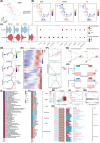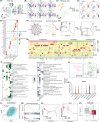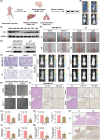Single-cell RNA sequencing elucidated the landscape of breast cancer brain metastases and identified ILF2 as a potential therapeutic target
- PMID: 38943472
- PMCID: PMC11533045
- DOI: 10.1111/cpr.13697
Single-cell RNA sequencing elucidated the landscape of breast cancer brain metastases and identified ILF2 as a potential therapeutic target
Abstract
Distant metastasis remains the primary cause of morbidity in patients with breast cancer. Hence, the development of more efficacious strategies and the exploration of potential targets for patients with metastatic breast cancer are urgently needed. The data of six patients with breast cancer brain metastases (BCBrM) from two centres were collected, and a comprehensive landscape of the entire tumour ecosystem was generated through the utilisation of single-cell RNA sequencing. We utilised the Monocle2 and CellChat algorithms to investigate the interrelationships among each subcluster. In addition, multiple signatures were collected to evaluate key components of the subclusters through multi-omics methodologies. Finally, we elucidated common expression programs of malignant cells, and experiments were conducted in vitro and in vivo to determine the functions of interleukin enhancer-binding factor 2 (ILF2), which is a key gene in the metastasis module, in BCBrM progression. We found that subclusters in each major cell type exhibited diverse characteristics. Besides, our study indicated that ILF2 was specifically associated with BCBrM, and experimental validations further demonstrated that ILF2 deficiency hindered BCBrM progression. Our study offers novel perspectives on the heterogeneity of BCBrM and suggests that ILF2 could serve as a promising biomarker or therapeutic target for BCBrM.
© 2024 The Author(s). Cell Proliferation published by Beijing Institute for Stem Cell and Regenerative Medicine and John Wiley & Sons Ltd.
Conflict of interest statement
The authors declare no conflicts of interest.
Figures







References
-
- Sung H, Ferlay J, Siegel RL, et al. Global cancer statistics 2020: GLOBOCAN estimates of incidence and mortality worldwide for 36 cancers in 185 countries. CA Cancer J Clin. 2021;71(3):209‐249. - PubMed
-
- Lin NU, Bellon JR, Winer EP. CNS metastases in breast cancer. J Clin Oncol. 2004;22(17):3608‐3617. - PubMed
-
- Corti C, Antonarelli G, Criscitiello C, et al. Targeting brain metastases in breast cancer. Cancer Treat Rev. 2022;103:102324. - PubMed
-
- Soffietti R, Pellerino A. Brain metastasis from HER2‐positive breast cancer: an evolving landscape. Clin Cancer Res. 2023;29(1):8‐10. - PubMed
-
- Wu S, Lu J, Zhu H, et al. A novel axis of circKIF4A‐miR‐637‐STAT3 promotes brain metastasis in triple‐negative breast cancer. Cancer Lett. 2024;581:216508. - PubMed
MeSH terms
Substances
Grants and funding
LinkOut - more resources
Full Text Sources
Medical
Miscellaneous

